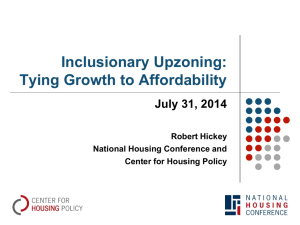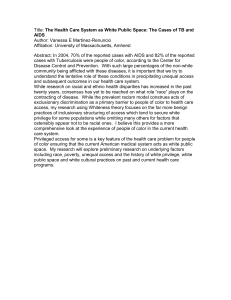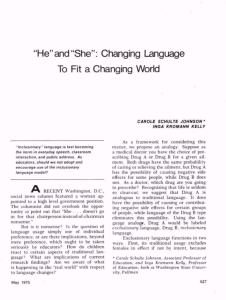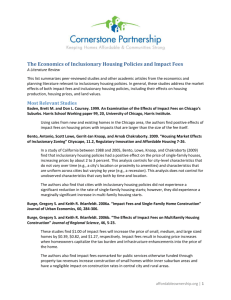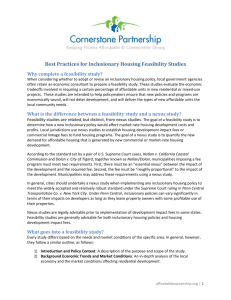In the simplest economic theory, if inclusionary housing policies lead
advertisement
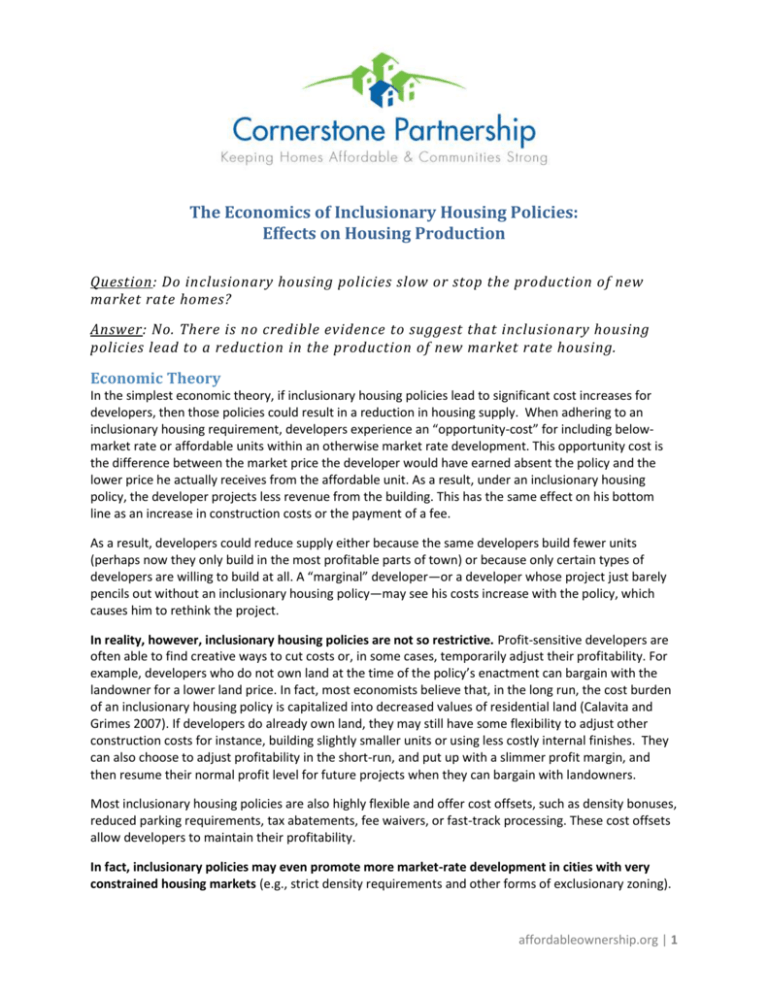
The Economics of Inclusionary Housing Policies: Effects on Housing Production Question: Do inclusionary housing policies slow or stop the production of new market rate homes? Answer: No. There is no credible evidence to suggest that inclusionary housing policies lead to a reduction in the production of new market rate housing. Economic Theory In the simplest economic theory, if inclusionary housing policies lead to significant cost increases for developers, then those policies could result in a reduction in housing supply. When adhering to an inclusionary housing requirement, developers experience an “opportunity-cost” for including belowmarket rate or affordable units within an otherwise market rate development. This opportunity cost is the difference between the market price the developer would have earned absent the policy and the lower price he actually receives from the affordable unit. As a result, under an inclusionary housing policy, the developer projects less revenue from the building. This has the same effect on his bottom line as an increase in construction costs or the payment of a fee. As a result, developers could reduce supply either because the same developers build fewer units (perhaps now they only build in the most profitable parts of town) or because only certain types of developers are willing to build at all. A “marginal” developer—or a developer whose project just barely pencils out without an inclusionary housing policy—may see his costs increase with the policy, which causes him to rethink the project. In reality, however, inclusionary housing policies are not so restrictive. Profit-sensitive developers are often able to find creative ways to cut costs or, in some cases, temporarily adjust their profitability. For example, developers who do not own land at the time of the policy’s enactment can bargain with the landowner for a lower land price. In fact, most economists believe that, in the long run, the cost burden of an inclusionary housing policy is capitalized into decreased values of residential land (Calavita and Grimes 2007). If developers do already own land, they may still have some flexibility to adjust other construction costs for instance, building slightly smaller units or using less costly internal finishes. They can also choose to adjust profitability in the short-run, and put up with a slimmer profit margin, and then resume their normal profit level for future projects when they can bargain with landowners. Most inclusionary housing policies are also highly flexible and offer cost offsets, such as density bonuses, reduced parking requirements, tax abatements, fee waivers, or fast-track processing. These cost offsets allow developers to maintain their profitability. In fact, inclusionary policies may even promote more market-rate development in cities with very constrained housing markets (e.g., strict density requirements and other forms of exclusionary zoning). affordableownership.org | 1 In these cases, a flexible inclusionary policy that allows inclusionary buildings to receive conditional use permits or variances from strict zoning code requirements create opportunities for developers to build more efficiently and creatively. As a result, these policies may lead to more development. Economic Evidence The highest quality study on the effect of inclusionary housing policies on housing production comes from Schuetz et al. (2009), who examine the impact of these policies on prices and production of market-rate housing production in Boston and San Francisco. These authors use a “difference-indifferences” approach, which controls for spatial characteristics that do not vary over time (e.g., a city’s proximity to the ocean) and characteristics that are uniform across geographies but vary by time (e.g., a statewide recession). Schuetz et al. (2009) found a trivial effect of inclusionary housing on housing production in Boston. They find that a 1 percent increase in the time since the policy was adopted is associated with a decrease in production of about 0.6 percent. That is, a six month increase in the age of policy is associated with a reduction of just two housing permits per year. They find no evidence that inclusionary housing policies lead to reductions in housing production in the Bay Area. In the study of Californian cities between 1988 and 2005, Bento et al. (2009) also use a similar sophisticated difference-in-differences approach. The authors found that inclusionary housing policies have no significant effect on the number of permits for single-family housing units. However, they do find that single-family permits as a share of total permits are lower in jurisdictions with inclusionary housing policies. This was the result of a marginally significant increase in multi-family housing where inclusionary housing policies are applied. This could be because those inclusionary housing ordinances included density bonus incentives and thus created the opportunity for more housing developments of higher density multifamily types of buildings. Using data from Los Angeles and Orange Counties, Mukhija et al. (2010) compare seventeen different municipalities with inclusionary housing policies adopted over a period of 35 years. They control for some observed characteristics, like a city’s unemployment rate as a proxy for housing market strength. Unlike the higher-quality Schuetz et al. (2009) paper, they do not control for unobserved geographic and temporal characteristics, like a city’s proximity to amenities or a statewide recession. Mukhija et al. (2010) find no statistically significant evidence of inclusionary zoning’s adverse effect on housing supply in cities with inclusionary mandates. There have also been a few descriptive studies that do not find an association between inclusionary housing policies and decreases in housing production. In a study of 28 Californian cities over a 20-year period, Rosen (2004) examined building permit data to test the association between inclusionary housing policies and the pace of development. He found no negative association. In some cases, housing production increased after the passage of an inclusionary housing policy. The California Coalition for Rural Housing and the Non-Profit Housing Association of Northern California (2004) also examined 107 inclusionary zoning policies in California and did not find any evidence that the policies were associated with slower rates of development. However, there has been one descriptive study that found an association between inclusionary housing and a decrease in housing production. In a study of cities in southern California, Powell and Stringham (2004) found that cities with inclusionary housing policies experienced a decline in housing permits of 10 to 30 percent in the seven years after the policies were adopted. Like the studies by Rosen (2004) and affordableownership.org |2 the California Coalition for Rural Housing and the Non-Profit Housing Association of Northern California (2004), this study should be interpreted as descriptive, and not causal. Summary There is no credible evidence to suggest that inclusionary housing policies lead to lower rates of housing production. This is likely because developers are able to adapt to flexible inclusionary housing policies by bargaining over land prices and adjusting their profits in the short run. Citations Bento, Antonio, Scott Lowe, Gerrit-Jan Knaap, and Arnab Chakraborty. 2009. “Housing Market Effects of Inclusionary Zoning” Cityscape, 11.2, Regulatory Innovation and Affordable Housing 7-26. Calavita, Nico and Kenneth Grimes. 2007. “Inclusionary Housing in California: The Experience of Two Decades.” Journal of the American Planning Association, 64 (2), 150-169. California Coalition for Rural Housing and the Non-Profit Housing Association of Northern California. 2004. “Inclusionary Housing in California: 30 Years of Innovation.” Inclusionary Zoning: The California Experience. National Housing Conference 3 (1). Mukhija, Vinit, Lara Regus, Sara Slovin, and Ashok Das. 2010. “Can inclusionary zoning be an effective and efficient housing policy? Evidence from Los Angeles and Orange Counties.” Journal of Urban Affairs 32.2, 229-252. Rosen, David. 2004. “Inclusionary Housing and its Impacts on Housing and Land Markets.” 2004. Inclusionary Zoning: The California Experience. National Housing Conference 3 (1). Schuetz, Jenny, Rachel Metzler, and Vicki Been. 2009. “Silver Bullet or Trojan Horse? The Effects of Inclusionary Zoning on Local Housing Markets.” Urban Studies. affordableownership.org |3
